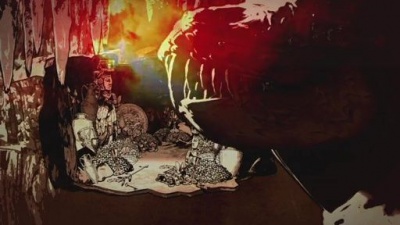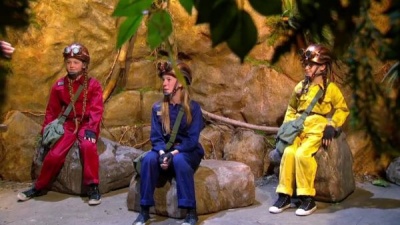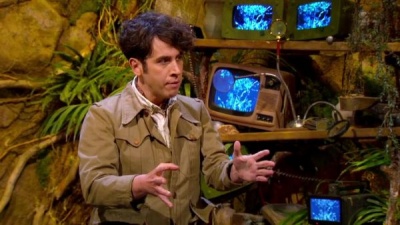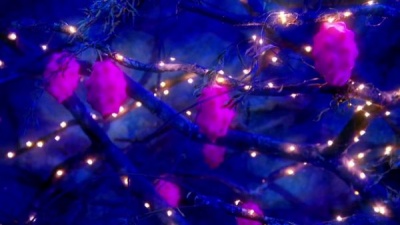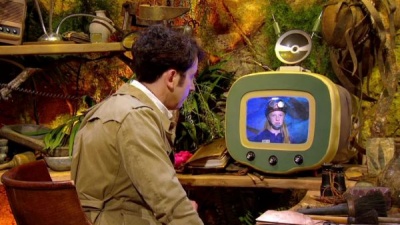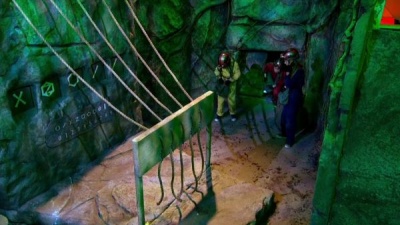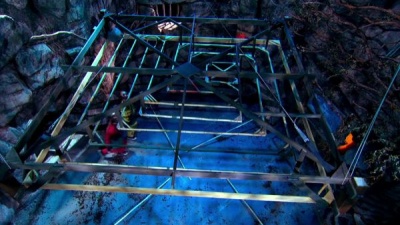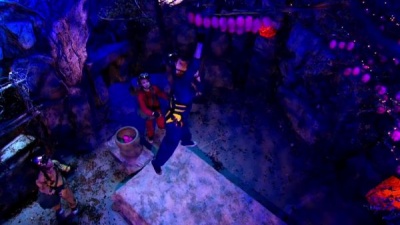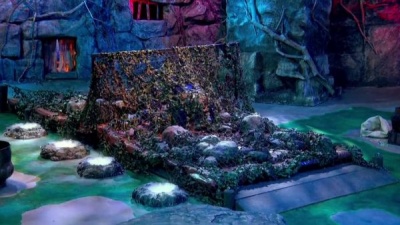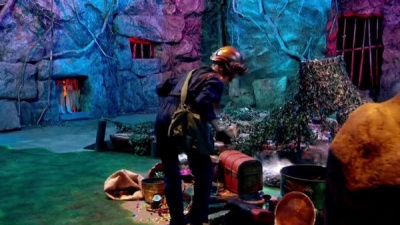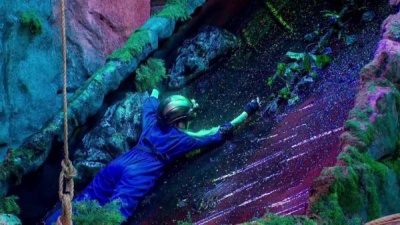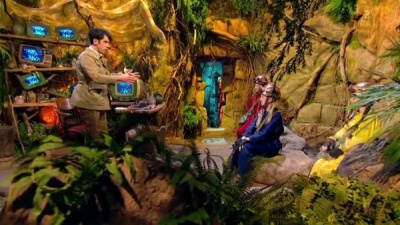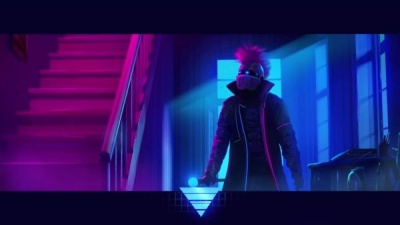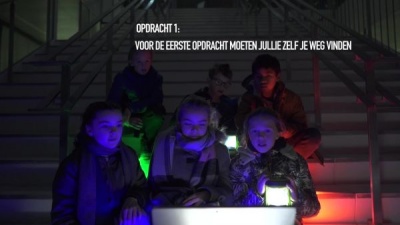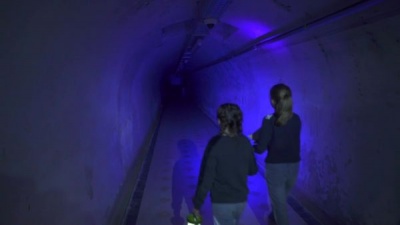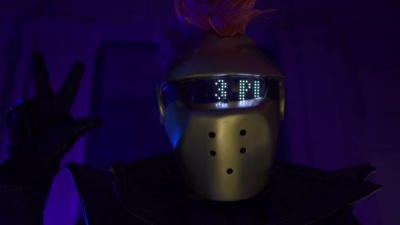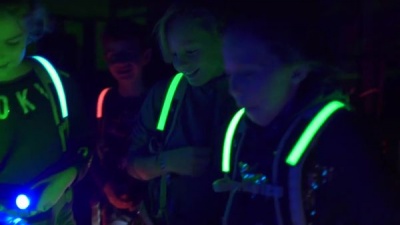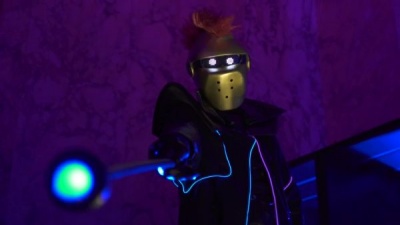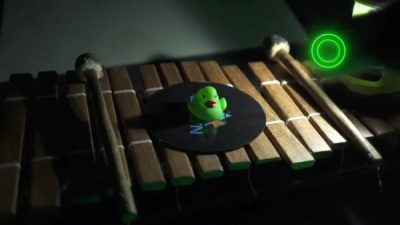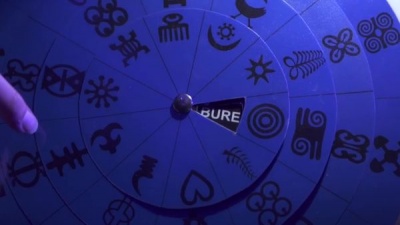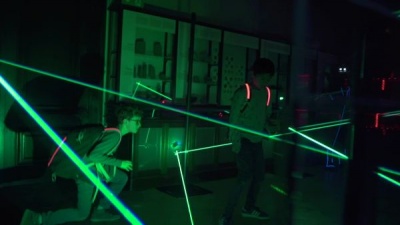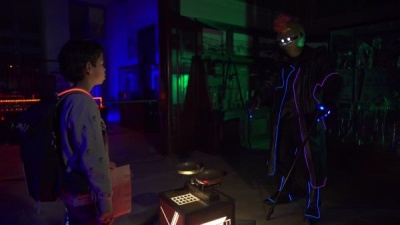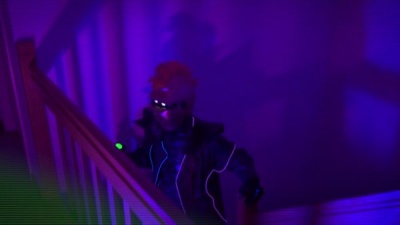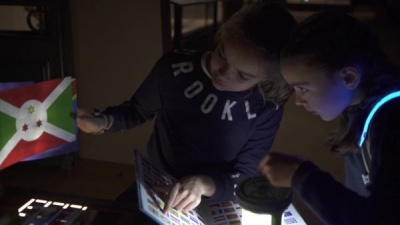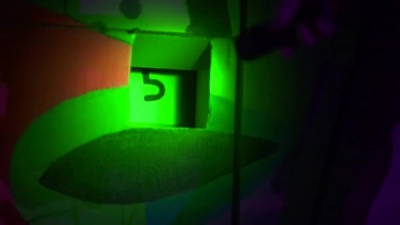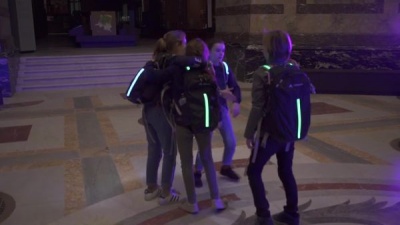Weaver's Week 2020-11-29
Last week | Weaver's Week Index | Next week
A pair of programmes for children: ITV's latest commission, and a Dutch-language show that glows in the dark.
Contents |
Don't Unleash the Beast
Tiny House Productions / CPL Productions for CITV, 2-23 November
It's still relatively unusual for CITV to make new competition shows – their core strategy is to target preschool children, and to make or acquire cartoons for older viewers. Still, we'll celebrate what we can get, and cheer the chance to big up CITV.
Even before the opening titles end, we can see they've spent time on the back story. The "Hallian" civilisation is exotic, not of these lands. It's also familiar, melding motifs from the Aztec and Mayan societies viewers might already have encountered.
In a concise opening, we learn that the Hallians had lots of treasure, which they buried in a cave system guarded by a beast. But the beast grew, and the Hallians fled to all corners. Now, the Professor requires help to retrieve treasures from the caves – all without unleashing the titular Beast. That took (checks watch) 35 seconds to explain on screen through stop-motion animation; someone can explain why The Bridge takes four times as long to impart less information.
The challenge is taken by teams of three players. They're in bright colours – royal blue, signal red, sparkling yellow. They meet The Professor, who briskly and clearly explains the rules to them. And to us viewers: we get to know the outline plot from the very start. The team talk a bit about how they're feeling, who is confident and who is planning for greatness.
Pete Firman plays "The Professor", who describes himself as "an expert on all things Hallian". Right from the start, we wonder if he's entirely on our side: if these artefacts are so important, and he knows so much, why doesn't he go after them himself? How come he goes on about "if – I mean when – you make it out"? Is The Professor in cahoots with The Beast, provide it with sport and extra food? It's an unusual place for a children's game show to be {1}, we don't recall another morally ambiguous lead character since the first series of Raven.
The set is awesome. In an exhibition centre in Manchester, they've created a complete cave system using polystyrene blocks and some moody lighting. It's big enough to have some steps, trapdoors that open and close, crawl spaces, and a great sense of atmosphere. Take 1 Scenic are responsible for this masterpiece of set construction, and a grand job they've done of it. Banks & Wag wrote the original music for the show.
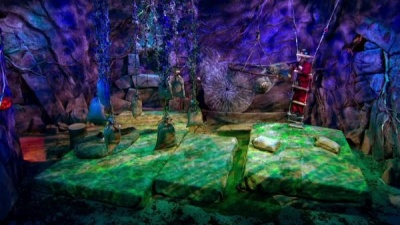 Grab the sacks on the left, throw them to the player on the right, and don't step on the toxic sludge.
Grab the sacks on the left, throw them to the player on the right, and don't step on the toxic sludge.
Across the show, our team will play four games before the big finale. They start in the North Caves with a physical game. This tests their ability to do a simple task repeatedly, and work as a team. In "Grain Store", one player swings out to collect bags of grain, and throws them to another player. The third player is up a rope ladder, to put the bags into a basket. Only when enough of the bags have been placed will the Symian Fruit be revealed.
The whattitty-whatt? The Symian Fruit. According to The Professor, these purple plants are the beast's only weakness. He eats them, and they put him to sleep. The more fruit he eats, the longer his doze will be. Across the game, it's possible to accumulate 36 Symian Fruit, and they're usually found growing in clumps of six.
Other physical games: Debris Tunnel, use a small truck to remove rock from a tunnel, and use them to lift a large rock covering fruit. Loggers' Gate, pass sticks of rock to build steps up to the fruit hanging from the roof. Transporter, climb on a frame to retrieve three poles.
After they've played the game and made their escape, the contestants give a short piece to camera, answering a question posed by The Professor. It's a way to bring out their personality a little more, and to vary the pace of the show. If it were all vam-vam-vam challenge, it would be a tiring watch, as we found in early iterations of Fort Boyard Ultimate Challenge.
Onwards to the West Caves, where there's a challenge for the mind. Most often, one player is isolated from the other two, and is to describe what they see, for the others to replicate. It could be a sequence of masks, as in "Mimic". Could be to recreate a series of sounds using bell-pulls, that's "Echo Chamber".
Or the challenge could be to spell a common English word using the Hallian alphabet, as on "Totem"; or use the Hallian number system to add up, as seen in "Pulley Vault". There's a very subtle piece of education here: different cultures will have different ways of writing, and that doesn't make them any less valid than Arabic numerals or Latin letters.
In each challenge, there's a time limit. We don't know how long it is, the contestants don't know how long the time is. All we know is that the Professor keeps on about his "beast tracker", how he can locate the enemy at any time. When the beast gets too close for comfort, he tells the team to abandon the quest for fruit and get themselves out of the caves. As a result, the beast never actually appears on screen. It's a psychological concept, an unrealised fear in the forefront of everyone's mind. A brave decision to have the title character never appear on screen.
The challenge continues in the East Caves, and there's going to be some precision needed to win the challenge. Sharp shots, pokey sticks, and rolling balls down chutes. By now, it's clear that these are team games, not a gazillion miles away from ones we might find on The Crystal Maze if they bothered to play team games. More pertinently, we're reminded of the challenges from Jungle Run, another immersive team challenge from CITV's past.
Skill games are: Tilt Maze, roll a ball around a maze using sticks. Fruit Drop, throw balls at small targets to dislodge fruit. Shape Shifters, hook in cogs to build a mechanism and open the box. Rock Roll, roll rocks down a chute to fill holes.
Another hole they've filled is in the budget. Don't Unleash the Beast is part-funded by the Young Audiences Content Fund. A total of £57 million from the Westminster government is available over three years to April 2022. The money is intended to alleviate the free market's continued failure to make quality shows on commercial television for young viewers, particularly those of school age. The gap in the market stems from hasty and ill-considered rules imposed in 2006, aimed primarily to enhance the career of Jamie Oliver. Hope he's paying some of the fund out of his own pocket.
But we digress. Don't Unleash the Beast received £789,345, likely to be half the production costs. Other shows receiving large chunks of the money include How on CITV, Mimi's World, Cymraeg drama Y Gyfrinach, Winnie & Wilbur, Don't Hug Me I'm Scared for Channel 4, and CITV/Aardman Animations' Lloyd of the Flies.
Whatever challenges have been faced so far, everyone finds The Symian Tree in the South Caves. One of the team is strapped into a bungee harness, and is to bounce up to a high branch where more fruit are located. It's a last chance to bag lots of fruit – fully half of the crop is in this one cave, and the setup ensures that even the worst teams have enough time to make the treasure room interesting.
While two of the players feed the fruit to the Beast, and send him to sleep, the other goes into the Cave of Treasures. An acidic bog blocks the entry, covered by a net of vines that can entangle explorers. Then it's a treasure hunt amongst several piles of things, to find the one item the Professor wants.
And then it's just a case of getting out. Up a remarkably slippery ramp, which seems to vary in slipperiness from episode to episode, but is never less than very slippery. Most teams are unable to find all three items, or escape up the ramp.
The few who do have conquered one of the hardest challenges, as difficult as the Final Chase. They're rewarded with another athletic day out, a hoodie, and a pendant. Everyone else gets eaten by the Beast.
Don't Unleash the Beast has many good ideas, and it's made with great care and attention, but we found the show to be slightly sterile. Much of that is the prevailing health advice: this series was filmed during the 2020 pandemic, which forced everyone to keep a distance from each other. The games were designed to keep people apart as much as possible: when one player retrieves bags, they throw it a short distance to another player, who relays it to the third player. There's no hugging, no high-fives, no fist-pumps, none of the closeness we'd expect from any television contest.
Another reason for the lack of atmosphere: the set is dark, and confined, and it looks like the sort of place where we might stumble across the skeleton of a previous explorer. Even the game spaces are lit in a partial light, there's lots of shadows around. This darkness adds to the visual atmosphere – it's a realistic imitation of a real cave system. But even when The Crystal Maze was in a mediaeval castle, there was always a lot of light in the games rooms – white walls and bright lights ensured we were never struggling to see.
Another difference is the sound design – there are long periods of quiet concentration on Don't Unleash the Beast. There isn't a team shouting "advice" from outside, as on Fort Boyard Ultimate Challenge. There isn't a pounding soundtrack, just some barely-audible music. When the teams don't need to talk, they tend not to talk – the treasure room seems designed to discourage shouting, and Pete Firman's Professor can only do so much to fill the gaps. It's not a low-stakes challenge, but it can feel like one at times.
We're impressed by what they've managed to achieve on Don't Unleash the Beast. It feels like the show was compromised by something – and we're going to pin most of the blame on the health restrictions. We very much hope to see a second series, recorded when all of this is a fading memory.
{1} While it's rare for children's game shows to require moral judgement, this isn't true of drama or cartoons. Over on the other side, both She-Ra and Itch have shifting goals and unclear motivations – and that's just from episodes shown this week.
Nachtraven
De Mensen for Ketnet, 2018-19
It's nominated for the Children's Award at the Rose d'Or ceremony tonight. It's available to watch internationally (run, don't walk to the Ketnet website). We're describing Reeks 2 Compilatie 6, which might still be the first show to play on the site.
There's a brief introduction, using animation and narration. The Nighthawk is a creepy character, it enters children's rooms while they sleep, and challenges them in the dead of night. All that's explained in 28 seconds flat, far faster than Channel 4's The Bridge. {2}
This week, the teams have been taken to the Africa Museum in Tervuren. We briefly meet the three pairs of players. They'll be coloured for our convenience, in blue, green, and red. And then, the teams discover their first mission. Succes, alles!
Opdracht Één is to follow the glow-in-the-dark arrows around the museum, collecting six pieces of a jigsaw puzzle as they go. When assembled, the jigsaw will form a picture, which matches one of the artefacts in the final room. Pick out the right artefact, present it to the Nachtraven, and perhaps win. This structure is explained to the viewers before the challenge begins, so we know what we expect to see.
Each team carries a lantern in their colour, and because this is often the only source of light, the colour coding looks entirely natural on screen. We can see – at a glance – that this is the red team, this is the blues, this is the greens. We don't need tags on screen, they've designed the colour into the show.
So we follow the teams around the museum – into the cinema, through the catacombs, access passages and exhibition halls. During this segment, we see how one of the teams were visited by Nachtraven in their bedroom. The character doesn't speak, but invites the children to follow by using the dot-matrix display that usually shows its eyes.
Eventually, the segment moves to a conclusion, the jigsaws are completed and the artefacts presented. First team to arrive gets 3 points, the next gets 2 and the last to finish picks up 1 point.
After completing the first game, our teams get a rucksack. It's got things that might be useful for survival – a map of the museum, some water – and some things for the game, like a magnifying glass. The rucksacks, like the lanterns, have colour-coded reflective strips. Our teams have a few minutes with some of the exhibits in the museum.
Eventually, they work out what they have to do for Opdracht Twee. And by "work out", we mean, "find the Nachtraven, and follow where its Staff of Light is pointing". Because, yes, the Nachtraven has a wooden pole with magical properties, just like CBBC's Raven of old, and Raven Of Old.
For this challenge, our teams will be moving around one of the main exhibition halls. They're given a jigsaw, which almost matches a map they've seen on the wall – but it's missing one detail, the name "Congo". That's the room where they need to go, because there's a locked box in there. How to unlock it? With a word, the Swahili translation of "free". Perhaps there are further instructions elsewhere in the room.
There are further clues just down the room – four symbols displayed on the wall. The symbols are unusual, and smart teams will note them down. All teams will find an instruction to collect four rings of different sizes, all in their team colours. The rings are concealed underneath things that don't belong in the Congo room, like a skateboard, a toy unicorn, or a rubber duck.
Once they've found all four rings, the team need to line them up with the same symbols they saw displayed on the wall. Did you note them down? Or remember where they are? Or just want to try all ten options until you see the right answer, "Bure". Once the chest's been unlocked, it's a simple task to pull out the smaller staff and present it to the Nachtraven. Again, 3 points for the fastest, then 2, then 1.
This challenge particularly reminded us of Channel 4's Codex, where teams were allowed to roam a large museum at night, meeting Tony Robinson at every turn. Except Codex was very much less cool, all its games were played on touchscreens, there were eliminations part-way through, and Tony Robinson didn't dress up in a glow-in-the-dark suit.
Both of these challenges have lasted for about 15 minutes of screen time. This isn't a coincidence, as each night of Nachtraven is made as three 15 minute programme, then edited together into these compilations. On this side of La Manche, the habit is to present the longer show first, then extract individual challenges – both CBBC's Raven and S4C's Prosiect Z have filled five minutes with isolated challenges. Only BBC Alba's Fitheach has gone the other way, spinning up its episodes into half-hour compilations.
Back in Tervuren, where the teams are at Opdracht Drie. It's a show in Dutch, it's set at night... they're required to have a Laserkammer, it's just expected. In this challenge, our teams will play one by one against the clock. They'll cover a short course, not breaking any of the beams.
Then they reach a table containing many small samples of rock. Their object is to retrieve these samples, by hooking the rock off the edge of the table and into their bag. The one teeny-tiny problem: lots of small lasers rise vertically from the table's edge and bar their way. The team will have to work carefully, not breaking a beam with the hook or the rock.
Should the team break the laser on the edge of the table, they have to do a penalty lap, crossing the same arrangement of beams as earlier. And if they break these beams, repeat the lap until they do it right. There's ten minutes to gather samples, and the team with most rock in their bag wins the round. Again, scores are 3-2-1, and whichever team's in last place overall after this round leaves the show.
The Nachtraven is a wordless character. The only sound it makes is an electronic grunt, a low-pitched noise somewhere between a cough and a bleep. The character says nothing, yet we understand the Nachtraven's message perfectly. It's all in the gestures. A grunt and then bang the floor with its staff, to silence the children's chatter. Point at one team, or point and sweep to include all of them. A grunt and a nod of the head to indicate approval, or even praise.
Two teams remain for the final challenge. They split up and answer questions. In this episode, the first challenge is to find the false flag: which of these is not the correct design?
When they get this right, balloons light up, and attached is an envelope. In the envelope, a mask. In the main hall, some cardboard boxes. Build the boxes to recreate the mask: one box is fixed in place.
If they've done it right, the holes in the boxes will line up with numbers on the wall behind. Use this number to unlock the buzzer, turn on the lights, and win the week. The prize? Spend the rest of the night in the museum.
Nachtraven is a late-night show. It's filmed in the dark, in that liminal time around midnight when the shadows and spooks have run of the earth. There's a delicious poetry in how the final game revolves around things that are not actually there.
And Nachtraven is a show that believes in its central idea. It's taken a simple concept – children solve puzzles in a museum – and runs as far as it can with it. Unlike other shows (Relic - Guardians of the Museum, for instance), Nachtraven doesn't burden itself with many words, or aim to be educational or worthy. The improving content is present, almost smuggled in.
We particularly love the way the teams literally carry their colour with them, in their lantern and their reflective strips. While the Nachtraven's habit of sneaking into children's bedrooms wouldn't fly on this side of La Manche, the rest of the character works brilliantly. It's unsettling and stylish and futuristic and stern, all at the same time. Our main takeaway is the atmosphere: spooky without being threatening.
Will Nachtraven win the Rose d'Or for best children's show? The raven's eye cannot foretell the future, but we do know one thing. It's won simply for being nominated. Nachtraven has come to this column's attention, we've been able to cheer for it, and none of this would have happened without the contest.
{2} The animation style – and colour palette – is similar to the Nightfall game on the CBBC website. Being far too old, we have no idea what happens in Nightfall.
In other news...
Jeopardy! is going down the "guest hosts" route, because no one person can replace Alex Trebek. The first guest host will be Ken Jennings, who won 74 daytime editions of the show. It's a slightly bizarre booking, as Ken Jennings will also be appearing on their new version of The Chase – as one of the Chasers. Over here, Anne Hegerty spent almost ten years as a Chaser before she got to host Brightest Family; one of their Chasers will be villain on one new show, referee on another.
Speaking of guest hosts, one of the highlights of BBC Christmas is 30 Years of Have I Got News for You, we expect to see contributions from all the important regulars – Marcus Brigstocke, Germaine Greer, Charles Kennedy, Lord Tubby of Lardington, and Angus Deayton.
Celebrity editions of The Wheel, The Hit List, and three celeb pairs try to scale The Wall. There's a one-off revival of Blankety Blank, some Masterchef specials, a Would I Lie to You, and a show they really ought to call Richard Osman's Ho-Ho-House of Games. Two celebrity editions of Sewing Bee are looming. So is Strictly Come Dancing's Top 25, a public vote for the best dances across all 25 series.
The season starts on 11 December with the first Crackerjack! Christmas show in 36 years. For younger viewers, expect specials of The Dog Ate My Homework, and Justin Fletcher's Gigglequiz. Almost as intellectually taxing are the usual specials of University Challenge and Only Connect, and a seasonal QI Christmas Quiz. Lucy Porter tells us that Celebrity Mastermind has had a new series recorded, though seeing as how the main series is dropped for any excuse at all, expect that to go out during Euro 2020.
Entertainment for Sunday teatime in the Junior Eurovision Song Contest online. A new series of I'm Sorry I Haven't a Clue begins on Radio 4 (Mon), and I'm a Celebrity finishes (VM1 and ITV, all week).
Great news for quiz fans, as Mastermind Cymru returns to S4C (Wed). For foodies, Scarlett Moffatt tells how Love Bites on ITV2. Great Local Menu returns in a festive edition (BBC2, from Tue). And we've unseen Celebrity The Crystal Maze on Channel 4 (Thu). Stars of Gladiators and 2point4 Children on next Saturday's Pointless Celebrities (BBC1), while Jenny Ryan props up Supermarket Sweep (ITV).
Photo credits: Tiny House Productions / CPL Productions, De Mensen, Hat Trick.
To have Weaver's Week emailed to you on publication day, receive our exclusive TV roundup of the game shows in the week ahead, and chat to other ukgameshows.com readers, sign up to our Google Group.


